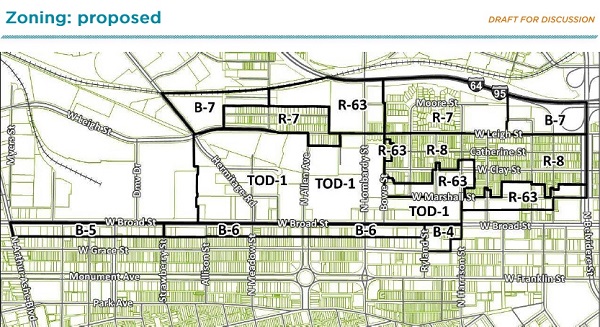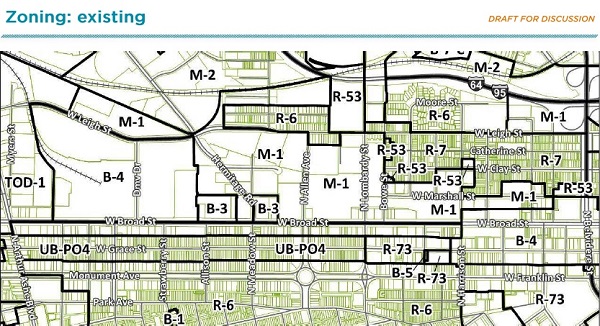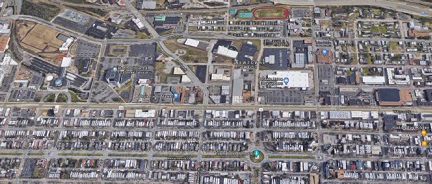
The latest proposal for Pulse zoning changes emphasizes TOD-1 zoning instead of B-4. (Images courtesy of the City of Richmond)
After shelving a first attempt amid neighborhood opposition, the City of Richmond has come back with a reworked approach to rezoning an area across Broad Street from the Fan that’s seeing an increase in interest from developers.
At Monday’s Planning Commission meeting, city planners presented their latest proposal for adjusting building heights and density in and around the Carver and Newtowne West neighborhoods, an area north of Broad generally between Belvidere Street and the DMV headquarters building.
Where the previous proposal focused heavily on B-4 Central Business District zoning, which would have allowed heights of 20 stories or more on some spots along Broad directly across from the Fan, the new proposal emphasizes TOD-1. Also known as Transit-Oriented Nodal District zoning, the designation limits buildings to 12 stories and has been applied along other parts of the Pulse rapid-transit bus line along Broad.
Acting Planning Director Kevin Vonck, who is presenting the plan to various neighborhood groups that opposed the last proposal, said the TOD approach seems to be a better fit for the area that’s transitioning from primarily manufacturing uses.
“As was discussed with Shockoe, I think there’s some consensus that the future of this area is no longer involved in manufacturing,” Vonck said, referring to the Shockoe Small Area Plan that’s likewise in the works. “Maybe a few small incidental manufacturing uses … but really the uses that are entailed in M-1 and M-2 are not the desired vision for the future land use of this area.”
He added, “TOD-1 does allow for a significant amount of density, but not nearly as much potentially as what a B-4 zoning would do.”
Vonck has been leading the effort, along with senior planner William Palmquist, since taking the helm of the department following the abrupt departure in January of previous director Mark Olinger, who advocated the B-4 approach.
While TOD makes up a good amount of the proposal, covering areas north of Broad from the DMV HQ to as far east as Harrison Street and north to Leigh Street, other residential and business zoning changes are also suggested to provide transitions between neighborhoods.
Along the south side of Broad, which is part of the residential Fan District but consists of commercial properties, the proposal suggests B-5 Central Business and B-6 Mixed-Use Business zoning changes. An existing B-4 area between Harrison and Ryland streets would remain unchanged. Those areas had originally been targeted for TOD-1 but were withdrawn from last year’s proposal due to concerns from the West Grace Street Association.
B-5 limits building heights to five stories, while B-6 generally encourages four stories.
The changes also would come with different parking requirements, which Planning Commissioner David Johannas voiced concerns about. The topic is top-of-mind for city leaders these days, as a proposal to amend the city’s zoning code to eliminate parking space minimums is headed to the City Council for consideration at its meeting Monday.
Noting that B-6 requires one space per unit, Johannas said, “That means that everybody that wants to build or do something in the B-6 range is really limited compared to everything else around it.”
“I understand the goal to find a district that can lower the heights of the buildings for the residents on West Grace Street, but I’m having a really difficult time understanding why we’d hamper development on that road regarding parking restrictions,” he said. “The parking restriction seems severe compared to everything we’re doing with TOD-1.”
Vonck acknowledged that B-6 comes with some additional parking restrictions, but he described the proposal as a starting point, with the base line option being no parking minimum requirements.
“Part of what we’re looking to do is balance concerns about the overflow of parking from some of these uses into the residential neighborhood directly to the south,” Vonck said, adding that a parking overlay district for the area could be another option.
“Every zoning district that we have has advantages and disadvantages. In this one, we’ve erred on the side of being conservative on the height and density in terms of what the base level for that would be,” he said. “The trade-off comes with some of the parking requirements that we’ve been discussing. There is some concern with B-6 about perhaps requiring too much, and concern with TOD about not requiring enough, and how that may impact the adjacent neighborhoods around it.”
City Councilmember Katherine Jordan, whose Second District includes the areas involved, told Vonck that she’s heard anecdotally that this latest proposal is receiving a positive reception from the community. Vonck agreed.
“From what I’ve taken,” Vonck said, “it feels like this at least is a starting point that maybe is more in line addressing some of the concerns that were brought up with the paper the first time around.”
Commission Chairman Rodney Poole said more work needs to be done with the proposal, considering the timing with the proposal to eliminate parking requirement minimums. Vonck said he’s aiming to formally propose the rezonings to the commission and council in June, but Poole said that timeline could be too optimistic.
“There’s got to be a way to protect West Grace Street but also allow development on Broad Street on the south side,” Poole said. “I know it’s a challenge.”
“I know we have a limited zoning ordinance and we have said the very first step of our ‘big steps’ is to rewrite the zoning ordinance, and we’re not going to be able to do that between now and June, when you want to present this to the City Council,” Poole said. “So, be thinking and be working on how you solve that dilemma of the protection of West Grace Street but the development of West Broad Street.”

The latest proposal for Pulse zoning changes emphasizes TOD-1 zoning instead of B-4. (Images courtesy of the City of Richmond)
After shelving a first attempt amid neighborhood opposition, the City of Richmond has come back with a reworked approach to rezoning an area across Broad Street from the Fan that’s seeing an increase in interest from developers.
At Monday’s Planning Commission meeting, city planners presented their latest proposal for adjusting building heights and density in and around the Carver and Newtowne West neighborhoods, an area north of Broad generally between Belvidere Street and the DMV headquarters building.
Where the previous proposal focused heavily on B-4 Central Business District zoning, which would have allowed heights of 20 stories or more on some spots along Broad directly across from the Fan, the new proposal emphasizes TOD-1. Also known as Transit-Oriented Nodal District zoning, the designation limits buildings to 12 stories and has been applied along other parts of the Pulse rapid-transit bus line along Broad.
Acting Planning Director Kevin Vonck, who is presenting the plan to various neighborhood groups that opposed the last proposal, said the TOD approach seems to be a better fit for the area that’s transitioning from primarily manufacturing uses.
“As was discussed with Shockoe, I think there’s some consensus that the future of this area is no longer involved in manufacturing,” Vonck said, referring to the Shockoe Small Area Plan that’s likewise in the works. “Maybe a few small incidental manufacturing uses … but really the uses that are entailed in M-1 and M-2 are not the desired vision for the future land use of this area.”
He added, “TOD-1 does allow for a significant amount of density, but not nearly as much potentially as what a B-4 zoning would do.”
Vonck has been leading the effort, along with senior planner William Palmquist, since taking the helm of the department following the abrupt departure in January of previous director Mark Olinger, who advocated the B-4 approach.
While TOD makes up a good amount of the proposal, covering areas north of Broad from the DMV HQ to as far east as Harrison Street and north to Leigh Street, other residential and business zoning changes are also suggested to provide transitions between neighborhoods.
Along the south side of Broad, which is part of the residential Fan District but consists of commercial properties, the proposal suggests B-5 Central Business and B-6 Mixed-Use Business zoning changes. An existing B-4 area between Harrison and Ryland streets would remain unchanged. Those areas had originally been targeted for TOD-1 but were withdrawn from last year’s proposal due to concerns from the West Grace Street Association.
B-5 limits building heights to five stories, while B-6 generally encourages four stories.
The changes also would come with different parking requirements, which Planning Commissioner David Johannas voiced concerns about. The topic is top-of-mind for city leaders these days, as a proposal to amend the city’s zoning code to eliminate parking space minimums is headed to the City Council for consideration at its meeting Monday.
Noting that B-6 requires one space per unit, Johannas said, “That means that everybody that wants to build or do something in the B-6 range is really limited compared to everything else around it.”
“I understand the goal to find a district that can lower the heights of the buildings for the residents on West Grace Street, but I’m having a really difficult time understanding why we’d hamper development on that road regarding parking restrictions,” he said. “The parking restriction seems severe compared to everything we’re doing with TOD-1.”
Vonck acknowledged that B-6 comes with some additional parking restrictions, but he described the proposal as a starting point, with the base line option being no parking minimum requirements.
“Part of what we’re looking to do is balance concerns about the overflow of parking from some of these uses into the residential neighborhood directly to the south,” Vonck said, adding that a parking overlay district for the area could be another option.
“Every zoning district that we have has advantages and disadvantages. In this one, we’ve erred on the side of being conservative on the height and density in terms of what the base level for that would be,” he said. “The trade-off comes with some of the parking requirements that we’ve been discussing. There is some concern with B-6 about perhaps requiring too much, and concern with TOD about not requiring enough, and how that may impact the adjacent neighborhoods around it.”
City Councilmember Katherine Jordan, whose Second District includes the areas involved, told Vonck that she’s heard anecdotally that this latest proposal is receiving a positive reception from the community. Vonck agreed.
“From what I’ve taken,” Vonck said, “it feels like this at least is a starting point that maybe is more in line addressing some of the concerns that were brought up with the paper the first time around.”
Commission Chairman Rodney Poole said more work needs to be done with the proposal, considering the timing with the proposal to eliminate parking requirement minimums. Vonck said he’s aiming to formally propose the rezonings to the commission and council in June, but Poole said that timeline could be too optimistic.
“There’s got to be a way to protect West Grace Street but also allow development on Broad Street on the south side,” Poole said. “I know it’s a challenge.”
“I know we have a limited zoning ordinance and we have said the very first step of our ‘big steps’ is to rewrite the zoning ordinance, and we’re not going to be able to do that between now and June, when you want to present this to the City Council,” Poole said. “So, be thinking and be working on how you solve that dilemma of the protection of West Grace Street but the development of West Broad Street.”





I hope that the city removes parking minimums, as has been proposed by Andreas Addison, or at least finds ways to require less in areas like this and the area around the Diamond (some of which may be zoned B-7, which also requires a lot of parking). Requiring a lot of parking drives up costs and forces developers to use valuable land for asphalt that is often empty. We need to come up with better solutions to parking issues, especially where the aim of the city is to encourage more density, more transit use, etc.
This is a very troubling backslide. In a city where mass transit and the density that can serve it are struggling to come into existence, we seem unable to achieve reforms strong enough to make a big impact on the city’s transportation and land use outlook. The TOD corridor should be high density and with no parking requirements. The fact that some people on grace street are objecting is really troubling, considering the proposed development is to the NORTH of them and will not cast shadows to the south. This is selfishness defined – the aesthetic preferences of a few… Read more »
The whole get rid of cars and parking has always been an economic disaster. Sure, you want to rid other people of cars, but few want to pay to use a bus. Connivence usually wins.
There are other things than the bus – Uber for example.
If parking is that good an idea, trust the developers to put it in. The idea that the city is better at making decisions about how much parking is needed than the people putting up the buildings is absurd
Developers are really good at being developers….as in making money. To even ask them to consider the long term benefits of their actions to the city as a hole is like asking a fish to speak Latin.
they know what is best for them, which is very different from knowing what is best.
so you hate the Fan? The Museum District? And you prefer Short Pump? The latter is the planned version…
you do realize that’s how the Fan and all the desirable neighborhoods in Richmond got built? People trying to make a profit?
Whereas the history of city mandates is generally one of failure?
You might want to think about Paris, and London, and New York, all of which would look like Dallas if your approach was used…
Charles; your argument strikes me as a faulty. I don’t see how you can compare a bunch of unregulated 10 story plus buildings with no parking and high density, to an area that was meant to have much lower population density, and rarely had many 3 story buildings.
Please feel free to point out any blocks of 10 story apartment buildings from the late 1800s I might be missing.
you’ve missed the point completely though? Simply put, the history of letting people make their own decisions is good.
The history of planning is bad.
People consistently vote with their feet and their dollars for the “unplanned” neighborhoods.
And for 10 story buildings, I gather you haven’t visited New York, Chicago, Boston etc? Might be educational
The bus is free right now. Try it out.
Remove parking requirements? Trust the developers to put in parking? Easy to propose if YOU don’t live in the neighborhoods impacted by vertical growth. Richmond needs more parking, not less. Developers are only in it for themselves when they build apartment buildings without a parking deck, or when the city eliminates on street parking. Who pays the price? The residents who’ve been in the neighborhood the entire time and now have to contend with gridlocked streets. Citizens first; newcomers last.
If you want a car you should be responsible for maintaining a place to park, not relying on what is available for free from the city. And yes you pay taxes for the city to maintain the street, but that’s not the same as paying for a dedicated parking spot.
So unless you can afford about 500K you should not be allowed to own a car in the Fan? The tax code is basically a means for extracting money from the poor and working class to support people who can afford lobbyists as it is. Taking away the right to park in a public space just to make life easier for real estate developers is a pretty amazing stance to take in public. Do you also want to take away the right to vote unless you own property? What is the threshold for citizenship in your world view? Is it… Read more »
This is an extremely unthoughtful take, these plans won’t affect the Fan at all. Where do you think the Fan tower is getting built? Do you actually realize what is being discussed?
The Fan, under this, will stay the same.
Housing will get more expensive unless more is built. You are advocating for making the Fan more expensive, while saying you want it less expensive. This is very confusing